Sustainable Solution
Jatropha curcas, often referred to as the “miracle tree,” is a drought tolerant, fast-growing shrub native to Central America. It has gained significant attention as a potential source of renewable energy and biofuel, particularly in arid and semi-arid regions. Jatropha curcas cultivation offers numerous advantages. Its hardy nature enables it to thrive in marginal lands unsuitable for conventional crops, reducing pressure on arable land. The plant’s high oil content in its seeds makes it an ideal feedstock for biodiesel production, providing a renewable alternative to fossil fuels. Additionally, jatropha curcas has medicinal properties and can be used for various purposes, including soap making, biofertilizer production, and livestock feed.
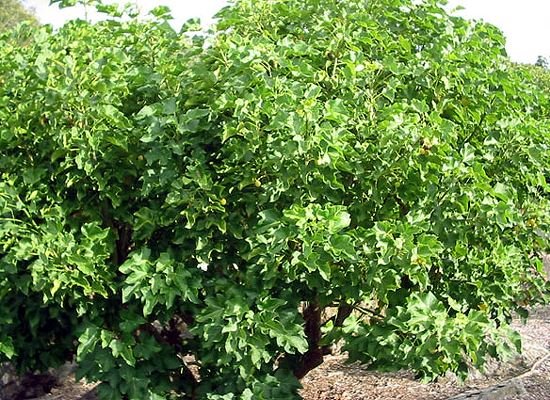
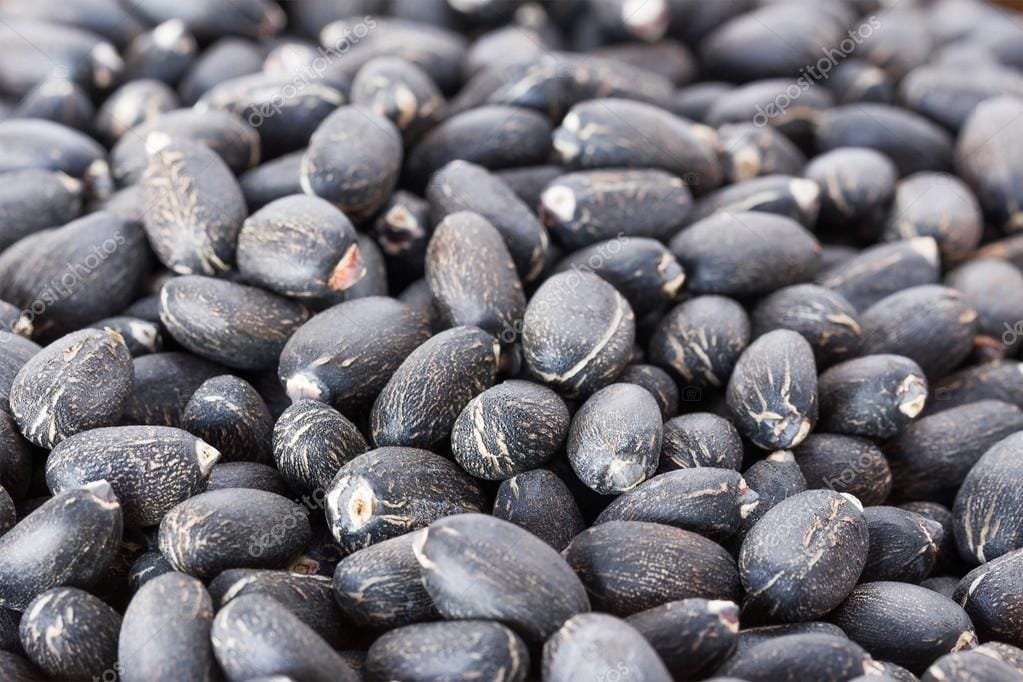
Introduction to Jatropha Curcas.
Jatropha curcas, commonly known as “physic nut” or “purge nut,” is a drought-tolerant, fast-growing, perennial shrub or small tree belonging to the Euphorbiaceae family. Native to Central America and the Caribbean, it has been cultivated for centuries for its oil-rich seeds, which offer potential as a renewable source of biodiesel and other valuable products.
Jatropha curcas has gained significant attention in recent years as a promising biofuel crop, particularly in regions with limited access to fossil fuels. The plant’s adaptability to harsh environments and its high oil content make it a valuable resource for sustainable energy production and rural development.
- Jatropha curcas is a hardy plant that can thrive in arid and semi-arid regions with minimal water requirements.
- Its seeds contain a high percentage of oil (approximately 30-40%), which can be extracted and processed into biodiesel.
- Jatropha curcas has the potential to reduce reliance on fossil fuels, improve energy security, and generate income for farmers.
- The plant’s oil can also be used in other applications, such as cosmetics, pharmaceuticals, and industrial lubricants.
However, the cultivation and utilization of Jatropha curcas come with challenges, including potential environmental impacts, concerns about toxicity, and the need for careful management to ensure sustainable production.
Botanical Characteristics of Jatropha Curcas
Jatropha curcas, commonly known as physic nut or purging nut, is a drought-tolerant, fast-growing, and hardy shrub belonging to the Euphorbiaceae family. It’s native to Central America but has naturalized in tropical and subtropical regions worldwide. The plant exhibits distinct botanical features that contribute to its resilience and potential for biofuel production.
Jatropha curcas is characterized by its distinctive tree-like appearance, reaching heights of up to 10 meters. The plant has a deep taproot system that enables it to access water from deep underground, making it particularly well-suited to arid and semi-arid environments. The leaves are palmately lobed and resemble those of a maple tree, with a glossy, green color. The plant produces small, yellow flowers that develop into capsules containing seeds with a high oil content.
Seed Characteristics
The seeds of Jatropha curcas are crucial for biofuel production. They are round and dark brown, typically measuring around 1-2 centimeters in diameter. Each seed contains an average of 30-40% oil, which is extracted and used to produce biodiesel. The seeds are also rich in other valuable compounds, including proteins, carbohydrates, and vitamins.
Understanding the botanical characteristics of Jatropha curcas is vital for optimizing cultivation practices and maximizing the plant’s potential for biofuel production. The plant’s unique features, including its drought tolerance, fast growth rate, and high oil content, make it a promising candidate for sustainable energy production in areas with limited water resources.
Climatic and Soil Requirements for Jatropha Curcas
Jatropha curcas, a drought-tolerant and fast-growing plant, thrives in specific climatic conditions and soil types. Understanding these requirements is crucial for successful cultivation and optimal yield.
Climate
Jatropha curcas prefers warm and humid climates with average annual temperatures ranging from 25°C to 35°C. It can tolerate temperatures as low as 10°C and as high as 45°C. The plant is well-suited to regions with low rainfall, but requires a minimum of 500mm of annual rainfall, preferably during the growing season. It also exhibits a high tolerance for drought conditions.
Sunlight
Jatropha curcas requires ample sunlight for optimal growth and seed production. A minimum of 6 hours of direct sunlight per day is recommended, although it can tolerate partial shade. It is crucial to select a planting site that receives adequate sunlight, ensuring the plant’s ability to photosynthesize effectively and produce a high yield of seeds.
Soil
Jatropha curcas can adapt to various soil types, but thrives in well-drained soils with good aeration. It can tolerate a wide range of pH levels, but prefers slightly acidic to neutral soils (pH 6.0 to 7.0). It can grow in sandy, loamy, and clay soils as long as they are not waterlogged. The ideal soil should have a good balance of nutrients, particularly nitrogen, phosphorus, and potassium.
Propagation and Cultivation of Jatropha Curcas
Local Names:
German (Purgiernussßaum); Luganda (kiryowa); Mandarin (yu-lu-tzu); Nepali (kadam); Portuguese
(mundubi-assu, purgueira); Sanskrit (kananaerend,parvataranda,kananaeranda); Spanish (piñón purgante,piñón, piñón vóci,piñón lechero,piñón botija,pinon,pinol,piñón
criollo); Swahili (mbono); Yoruba (Ewe Lapalapa funfun); Ewe Iyalode or Botuje.
BOTANIC DESCRIPTION
Jatropha curcas is a perennial, monoecious shrub or small tree up to 6 m high; bark pale brown, papery, peeling; slash exudes a copious watery
latex, soapy to tough but soon becoming brittle and brownish when dry; branches glabrous, ascending, stout. Leaves alternate, palmate, petiolate, stipulate; stipules minute; petiole 2-20 cm long, blade 3-5 lobed, 12.5-18 x 11-16 cm, lobes acute or shortly acuminate at the apex, margins entire or undulating, leaf base deeply
cordate, glabrous or pubescent only on the veins below, basal veins 7-9, prominent, venation reticulate. Inflorescence a cyme formed terminally on branches and complex,
possessing main and co-florescences with paracladia. The plant is monoecious and flowers are unisexual; occasionally hermaphroditic flowers occur; 10 stamens arranged in 2 distinct whorls of 5 each in a single column in the androecium and in close proximity to each other. In the gynaecium, the 3 slender styles are connate to about 2/3 of their length, dilating to a massive bifurcate stigma. Female flowers with sepals up to 18 mm long, persistent; ovary 3-locular, ellipsoid, 1.5-2 mm in diameter, style bifid. Fruit an ellipsoid capsule 2.5-3 cm long, 2-3 cm in diameter, yellow, turning black. Seeds black, 2 per cell, ellipsoid, triangular-convex, 1.5-2 x 1-1.1 cm. The meaning of the specific name ‘curcas’ is not known. It was first given 400 years ago to ‘certain seeds’ by the Portuguese doctor Garcia de Orto, who published a work on Indian medicinal and drug plants in 1563.
Harvesting and Processing of Jatropha Curcas Seeds
Harvesting Jatropha curcas seeds is a crucial step in the production process, as it directly impacts the quality and yield of the final product. The optimal time for harvesting is when the seed pods have turned brown and dry, typically 6-8 months after flowering. This ensures that the seeds are mature and contain the highest concentration of oil.
1
Harvesting
Mature seed pods are carefully detached from the branches, either manually or using mechanical harvesters. This process should be done with caution to avoid damaging the plant or causing seed loss.
2
Drying
The harvested seed pods are then spread out in a well-ventilated area to dry thoroughly. This can be done under the sun or using artificial dryers. Proper drying is essential to prevent mold and fungal growth, which can affect seed quality.
3
De-podded
Once dried, the seed pods are de-podded to separate the seeds from the husks. This can be done manually or using threshing machines.
4
Cleaning
The extracted seeds are further cleaned to remove any remaining debris, dust, or impurities. This ensures that only high-quality seeds are used for oil extraction.
After harvesting and processing, the seeds are ready for oil extraction. This involves crushing the seeds and extracting the oil using various techniques, such as mechanical pressing or solvent extraction. The extracted oil can then be refined and used in various applications, including biodiesel production, cosmetics, and pharmaceuticals.
Jatropha Curcas Oil Extraction and Utilization
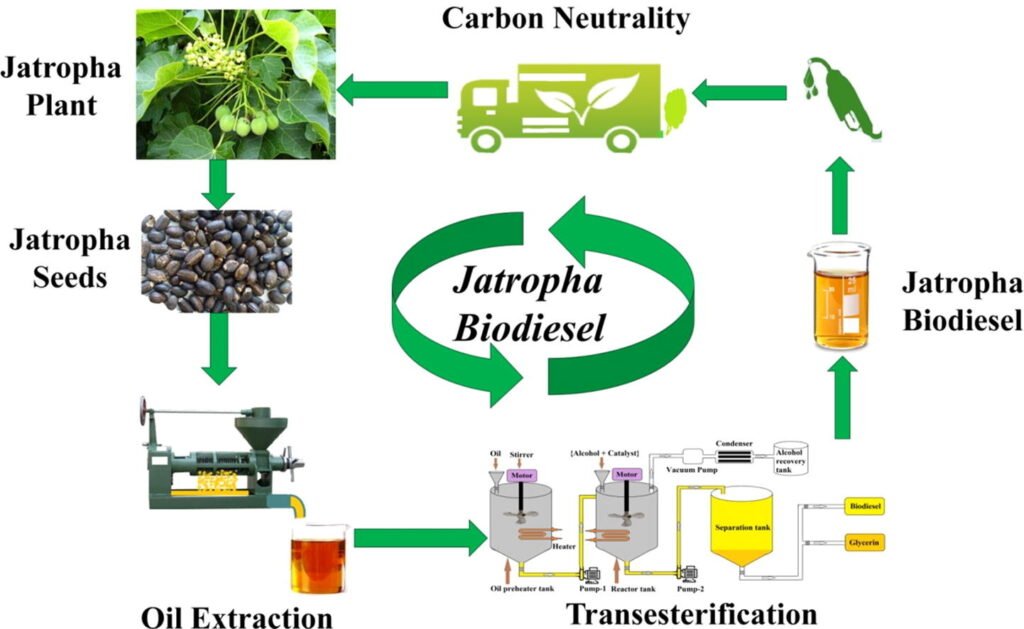
Jatropha curcas oil extraction is a multi-step process that begins with harvesting mature seeds. The seeds are then dried and cleaned to remove impurities, ensuring high-quality oil extraction. The oil is extracted using various methods, including mechanical pressing and solvent extraction. Mechanical pressing involves crushing the seeds to extract oil through pressure, while solvent extraction uses solvents to dissolve the oil from the seed material. The choice of extraction method depends on factors such as the scale of operation and desired oil purity.
Jatropha curcas oil finds a wide range of applications, primarily as a biodiesel feedstock. Biodiesel is a renewable and sustainable fuel derived from vegetable oils or animal fats, offering a cleaner alternative to fossil fuels. The oil can also be used in various industrial applications, including as a lubricant, soap-making ingredient, and bio-based polymer production. Its high energy content and unique properties make it a valuable resource for sustainable energy and bio-based industries.
The oil’s potential as a renewable energy source has made Jatropha curcas cultivation increasingly attractive. However, it’s crucial to consider the environmental impacts associated with large-scale oil palm production, including land use change, deforestation, and potential toxicity from seed residues. Sustainable practices, such as utilizing marginal lands and implementing responsible waste management, are essential to mitigate these concerns and ensure the long-term viability of Jatropha curcas oil production.
Economic and Environmental Benefits of Jatropha Curcas Farming
Jatropha curcas farming offers a multitude of economic and environmental benefits, making it a promising alternative to traditional biofuel sources. Here’s a closer look at these advantages:
30M
Tons of Biodiesel
Globally, Jatropha curcas can produce an estimated 30 million tons of biodiesel per year, contributing to a greener energy future.
$100B
Global Market
The global Jatropha curcas market is expected to reach a value of $100 billion by 2025, driven by rising demand for biofuel.
10%
Land Use
Jatropha curcas can thrive on marginal lands unsuitable for food crops, reducing pressure on arable land.
90%
CO2 Reduction
Jatropha curcas biodiesel can reduce carbon dioxide emissions by up to 90% compared to fossil fuels.
Jatropha curcas is a drought-tolerant, fast-growing plant that requires minimal water and fertilizer, making it a sustainable and low-maintenance crop. Its adaptability to marginal lands reduces pressure on arable land used for food production. The oil extracted from Jatropha curcas seeds is a highly efficient and renewable biofuel that can significantly reduce greenhouse gas emissions.
Beyond its biofuel potential, Jatropha curcas also provides economic opportunities in rural communities. It creates employment opportunities in cultivation, processing, and oil extraction, fostering local economic development. The plant’s byproducts, such as the seed cake, can be used as fertilizer and animal feed, further enhancing its economic value.
Biology
Pollination is by insects. The rare hermaphroditic flowers can be selfpollinating.
After pollination the trilocular ellipsoid fruit is formed. The
exocarp remains fleshy until the seeds are mature. In Thailand, there are
2 flowering peaks, in November and May. In permanently humid equatorial
regions, flowering occurs throughout the year. Fruit development needs 90
days from flowering until seeds mature.
Shrubs begin to produce at 4-5 months and reach full productivity at about
3 years. The female flowers are 4-5 times more numerous than the male
ones.
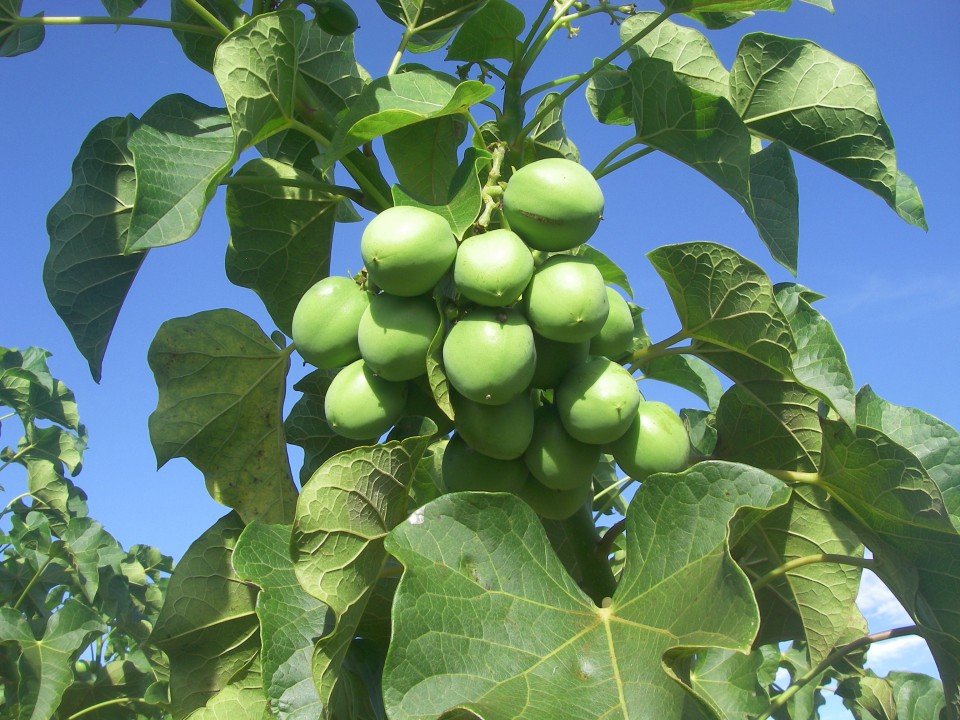
ECOLOGY
As a succulent that sheds its leaves during the dry season, J. curcas is best adapted to arid and semi-arid conditions. Most Jatropha spp. occur in the following seasonally dry areas: grassland-savannah and thorn forest scrub but, are completely lacking from the moist Amazon region. The current distribution of J. curcas shows that introduction has been most successful in drier regions of the tropics. It is very tolerant and thrives under a wide range of climatic and edaphic conditions. It is particularly hardy at medium altitude and in humid zones. It is not sensitive to day length. J. curcas is a highly adaptable species, but its strength as a crop comes from its ability to grow on poor, dry sites. It is very drought tolerant and can withstand slight frost.
BIOPHYSICAL LIMITS
Altitude: 0-500 m, Mean annual temperature: 20-28 deg. C, Mean annual rainfall: 300-1000 mm or more. Soil type: Grows on well-drained soils with good aeration and is well adapted to marginal soils with low nutrient content. On heavy soils, root formation is reduced.
PRODUCTS
Food: In Guinea, ashes from the roots and branches are used as cooking salt. Young leaves may be safely eaten when steamed or stewed. Cooked nuts are eaten in certain regions of Mexico
Fuel: Jatropha oil is an environmentally safe, cost-effective renewable source of non-conventional energy and a promising substitute for diesel, kerosene and other fuels. Physic nut oil was used in engines in Segou, Mali, during World War II. The oil burns without smoke and has been employed for street lighting near Rio de Janeiro.
Fruit hulls and seed shells can be used as a fuel. Dried seeds dipped into palm oil are used as torches, which will keep alight even in a strong wind. The wood was used as fuel, though of poor quality, in Cape Verde.
Tannin or dyestuff: Leaf juice stains red and marks linen an indelible black. The 37% tannin found in bark is said to yield a dark blue dye; latex also contains 10% tannin and can be used as marking ink. Ashes from the roots and branches
are used in the dyeing industry, and pounded seeds in tanning in Ghana.
Lipids: The seeds yield up to 31-37% of a valuable oil. It is used to prepare varnish after calcination with iron oxides. Hardened physic nut oil could be a satisfactory substitute for tallow or hardened rice bran oil. In Europe it is used in
wool spinning and textile manufacture. Along with burnt plantain ashes, oil is used in making hard homemade soap.
Wax: The bark contains a wax composed of a mixture of ‘melissyl alcohol’ and its melissimic acid ester.
Poison: Curcas oil contains a toxin, curcasin. The albumen of the kernel is a poison, toxalbumen cursin, most abundant in the embryo. Another poison, a croton resin, occurs in the seeds and causes redness and pustular eruptions of the
skin. The plant is listed as a fish poison. Aqueous extracts of J. curcas leaves were effective in controlling Sclerotium spp., an Azolla fungal pathogen.
The seed oil, extracts of J. curcas seeds and phorbol esters from the oil have been used to control various pests, often with successful results. In Gabon, the seeds, ground and mixed with palm oil, are used to kill rats. The oil has purgative
properties, but seeds are poisonous; even the remains from pressed seeds can be fatal.
Medicine: Seeds were formerly exported from the Cape Verde Islands to Portugal and the ‘curcas’, or purging oil, from them is a drastic purgative. They resemble groundnuts in flavour, and 15-20 seeds will cause griping, purging and vomiting for 30 minutes. It is reported from Gabon that 1-2 roasted seeds are sufficient to act as a purgative; larger doses may be dangerous. The seeds have been substituted for castor oil and are sometimes called ‘larger castor oil’. The oil is widely used for skin diseases and to soothe pain such as that caused by rheumatism; it is an ingredient in the oily extract, known in Hausa as ‘kufi’, which is a rubifacient for rheumatism and for parasitic skin conditions.
The oil is used to stimulate hair growth. The seeds are also used in the treatment of syphilis. Juice or latex is applied directly to wounds and cuts as a styptic and astringent to clean teeth, gums, and to treat sores
on the tongue and in the mouth. Branches are used as a chewing stick in Nigeria. Latex has antibiotic properties against Candida albicans, Escherichia coli, Klebsiella pneumoniae, Staphylococcus aureus and Streptococcus pyogens. It also has coagulating effects on blood plasma. A methanol extract of physic nut leaves afforded moderate protection for cultured human lymphoblastoid cells against the cytopathic effects of the human immunodeficiency virus.
Preparations of the plant, including seeds, leaves and bark, fresh or as a decoction, are used in traditional medicine and for veterinary purposes. A leaf infusion is used as a diuretic, for bathing, to treat coughs, and as an enema in treating convulsions and fits. Leaves are also used to treat jaundice, fevers, rheumatic pains, guinea worm sores and poor development of the fetus in pregnant women.
The leaves produce a sap that has haemostatic properties; it is used to dress wounds.
In Ghana the ashes from the burnt leaves are applied by rectal injection for haemorrhoids. The root bark is used to relieve the spasms of infantile tetanus and is used for sores, dysentery and jaundice. The juice of the flowers has numerous medicinal qualities.
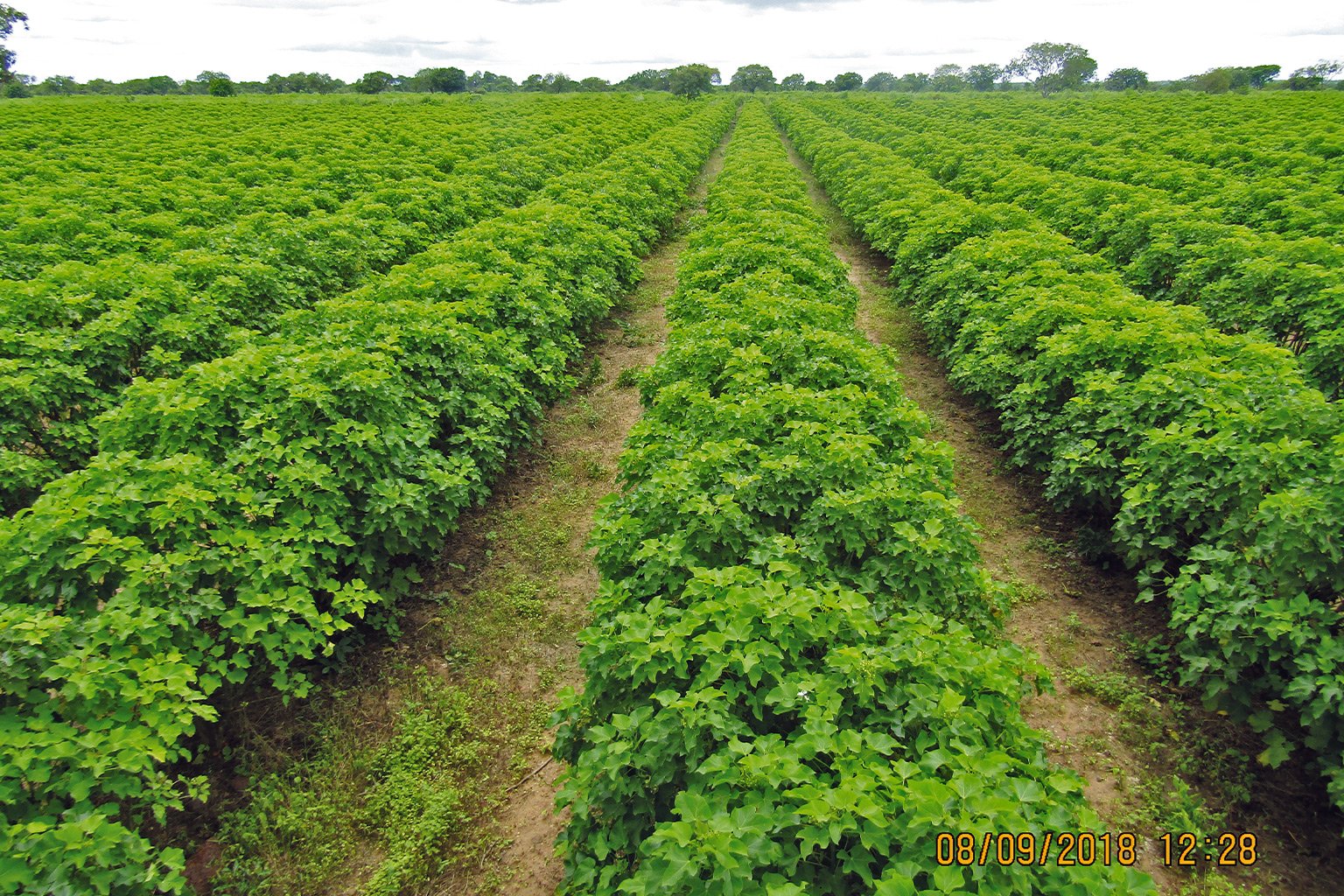

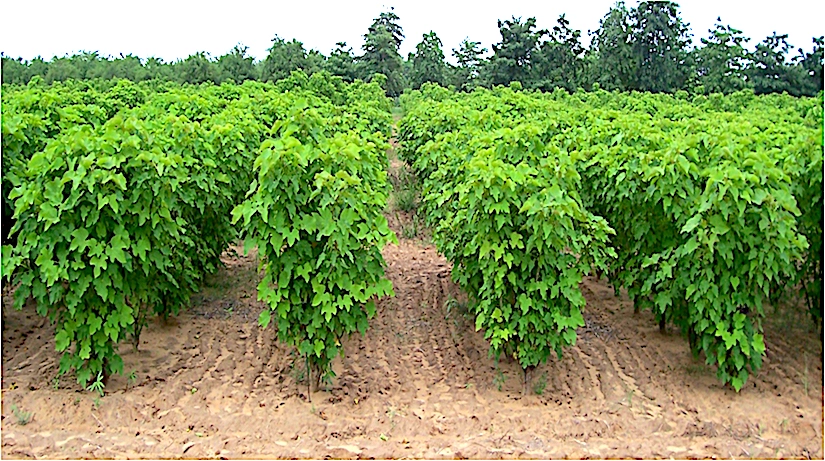
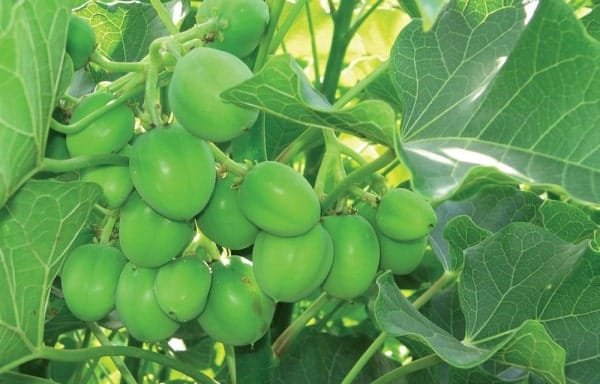
Challenges and Considerations in Jatropha Curcas Farming
While Jatropha curcas holds significant potential as a biofuel source, its cultivation faces several challenges that need to be addressed for sustainable and profitable farming.
- Low Seed Yield: One of the primary obstacles is the relatively low seed yield per plant. This can be attributed to factors such as genetic variation, environmental conditions, and susceptibility to pests and diseases.
- Seed Toxicity: Jatropha curcas seeds contain toxic compounds that require careful processing and extraction to ensure safe handling and utilization. This adds complexity and cost to the overall process.
- Land Requirements: Jatropha curcas cultivation requires a significant amount of land, which can be a concern in areas with limited arable land resources.
- Market Volatility: The market for Jatropha curcas oil is still developing, and prices can fluctuate, creating uncertainty for farmers.
In addition to these challenges, careful consideration needs to be given to environmental sustainability. Jatropha curcas can be invasive, potentially displacing native vegetation and impacting biodiversity. Responsible land management practices, including proper planting distances and integrated pest management, are crucial to minimize environmental risks.
SERVICES
Erosion control: In Cape Verde, J. curcas was recently planted in arid areas for soil-erosion control.
Nitrogen fixing:
Soil improver: Press cake cannot be used in animal feed because of its toxic properties, but it is valuable as organic manure due to a nitrogen content similar to that of seed cake from castor bean and chicken manure. The nitrogen content ranges from 3.2 to 3.8%, depending on the source. Tender branches and leaves are used as a green manure
for coconut trees. All plant parts can be used as a green manure. Boundary or barrier or support: Widely cultivated in the tropics as a living fence in fields and settlements. J. curcas is not browsed by cattle; it can grow without protection and can be used as a hedge to protect fields. Intercropping: In Madagascar, the plant is used as a support for vanilla.
TREE MANAGEMENT
Seedlings are susceptible to competition from weeds during their early development. Therefore weed control, either mechanical or with herbicides, is required during the establishment phase. Satisfactory planting widths are 2 x 2 m, 2.5 x 2.5 m, and 3 x 3 m. This is equivalent to crop densities of 2500, 1600 and 1111 plants/ha, respectively. Under good rainfall conditions, nursery plants bear fruit after the 1st rainy season, while directly seeded plants bear for the 1st time after the 2nd rainy season. With vegetative propagation, the 1st seed yield is higher. At least 2-3 t of seeds/ha can be achieved in semi-arid areas. Live fences can be established quickly by planting cuttings directly in the field. Pruning as a hedge is a frequent practice. J. curcas has a productive life of 40-50 years without necessitating replanting or tending.
GERMPLASM MANAGEMENT
Seeds are oily and do not store for long. Seeds older than 15 months show viability below 50%. High levels of viability and low levels of germination shortly after harvest indicate innate (primary) dormancy.
PESTS AND DISEASES
Some pests and diseases have been observed on J. curcas in Senegal; in Zimbabwe, powdery mildew damages leaves and flowers, Alternaria causes premature leaf fall, and golden flea beetles eat young leaves and shoots. In other countries pests and diseases do not cause severe problems although millipedes can cause total loss of young
seedlings. J. curcas is a host for cassava viruses.




